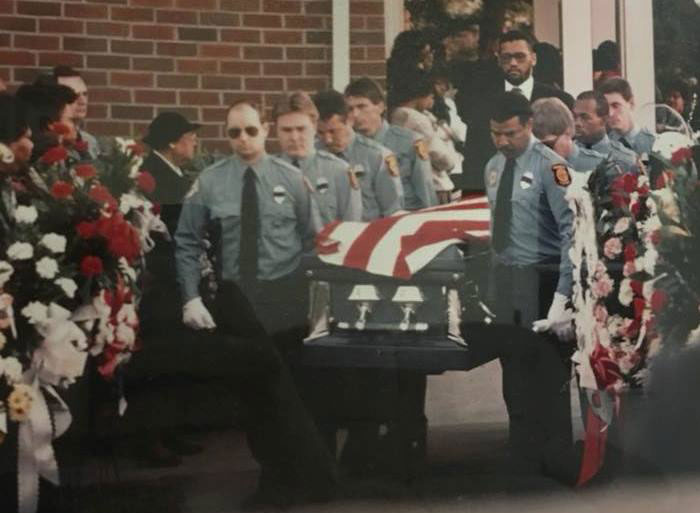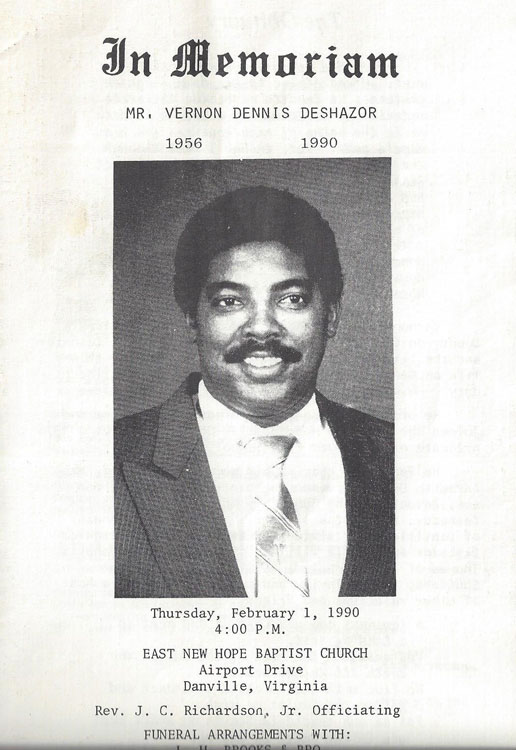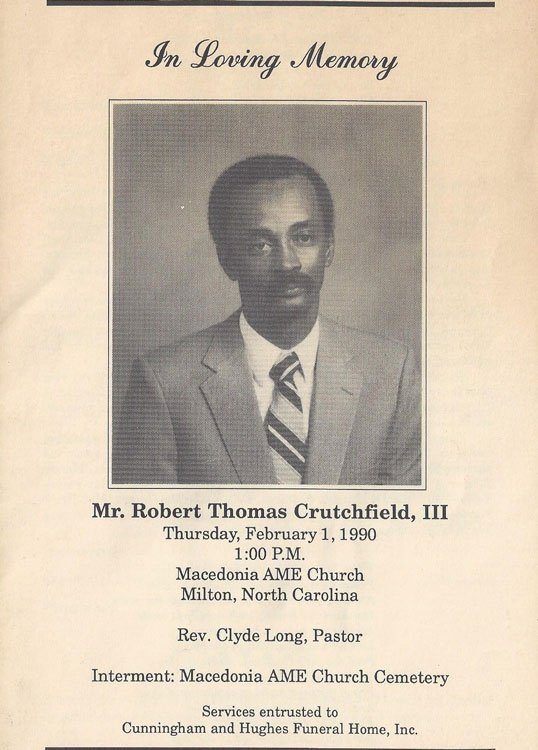
On January 28, 1990, Danville (VA) Fire Department Firefighters Robert T. Crutchfield III and Vernon Dennis Deshazor perished in a house fire on Guilford Street. The investigation revealed that an unknown toxin potentially contributed to the cause of death. Captain Bobby L. Johnson retired on disability as a result of this fire. All three firefighters were found in cardiac arrest in a small bathroom and partially in the hallway. Captain Johnson was revived on the scene, Crutchfield and DeShazor died at the scene. Above, fire department members and pallbearers escort City of Danville Firefighter Dennis DeShazor who was killed in the line of duty. Photos courtesy Wesley T. Marshall.
Since the beginning of time, firefighters have continually faced things that will injure, harm, or kill them. Many of these “things” have been identified, researched, and documented to the fullest extent. But that doesn’t mean we should be content with simply knowing about what can take us out of the career we love. Line-of-duty deaths (LODDs) continues to plague today’s fire service, even with the best safety practices and procedures. Firefighter death (on and off the job) should no longer be acceptable to this admirable profession. Dr. Burton Clark, author of the book I Can’t Save You but I’ll Die Trying, states: “When a firefighter is killed or injured, something went wrong. It is not part of the job. We can and must behave differently.” (Clark, pg. 31). I wholeheartedly agree with this observation. We should no longer accept death as part of the firefighting profession. In my 30-year career as a firefighter, I have had the misfortune of living through two LODDs, one of them a brother who I went through rookie school with. Both firefighters died in the same structure fire from heart failure due to unspecified related issues. The official NIOSH and OSHA reports never identified what exactly killed Dennis DeShazor and Robert Crutchfield. It doesn’t change the fact they both died on the fireground doing what they loved. With that being said, here are seven issues affecting the health and safety of today’s firefighter.
The Seven Deadly ‘C’s
1. Coronary Heart Disease. In the 2017 study from the National Fire Protection Association, “Firefighter Deaths by Cause and Nature of Injury,” heart attacks are still the Number One killer of firefighters on the fireground and in training, with 38 percent of firefighter deaths in 2017 due to cardiac arrest. Even with the best efforts of trying to reduce LODDs, firefighters still die due to heart failure. Firefighter health and safety have been studied and practical solutions identified to improve the overall wellness of today’s firefighter, yet heart attacks are still killing our brothers and sisters. Yearly physicals, programs outlining healthier food and life choices, exercise equipment in the stations, and other heart healthy processes are continually being offered and implemented, yet we still lose our brothers/sisters to heart failure. This “C” we can somewhat control. Stay fit and use good judgement when preparing meals in the firehouse. Your life depends on it.
RELATED: Surviving the Fire Service Cardiac Epidemic | Acute Coronary Syndromes in Firefighters: An ‘Athletic’ Approach to Prevention
2. Cancer. This menace is quickly creeping to the top of this list of killers. According to the Firefighter Cancer Alliance, “Cancer is the second leading cause of deaths among firefighters today, following cardiovascular disease, as established by numerous scientific studies and data collected and evaluated by the National Institute for Occupational Safety and Health and by the International Association of Fire Fighter’s (IAFF) Line of Duty Deaths Database”(Firefighter Cancer Alliance.org). Many departments are taking proactive measures in the prevention of job-related cancer. Reducing the exposure to carcinogens has been the topic of discussion since the attacks of 9/11. Non-tobacco use policies, washing and cleaning turnout gear (including gloves and hoods), on-scene decon, backup gear, and having washers and dryers in the stations are all measures being implemented to help reduce the risk of occupational cancer. There have been numerous articles written and studies done addressing cancer in the fire service. The one area I personally feel needs more attention is documentation. With cancer presumption and workers compensation claims, the “burden of proof” is often on the firefighter. One must prove they acquired cancer doing the job of firefighter. According to Firefighter Close Calls, cancer is still not recognized as an LODD. A recently published article stated “The issue of Firefighter cancer is clearly in the forefront, but yet currently, only the IAFF (based upon details from each local) recognizes cancer as a Line of Duty death” (Firefighter Close Calls.com). Developing new software to track firefighter exposure to carcinogens should be a point of concern for fire departments and even union locals. The ultimate goal of protecting firefighters should be our top priority. Documenting things firefighters are exposed to will help protect them and their families down the road. Cancer often doesn’t surface until many years after exposure.
RELATED: Firefighters and the Cancer Beast | Firefighter Cancer Prevention: Using the Tools Provided to Us
3. Coping (or the lack of). Suicide has been identified as the Number One killer of firefighters away from the fireground, and post-traumatic stress disorder (PTSD) has become a real issue with public safety personnel. The problem of suicide requires immediate attention. We have been programmed since our first day on the job to be tough and “suck it up.” Showing emotion or talking about incidents was taboo, and reaching out for help was a sign of weakness. Nothing could be further from the truth. We are not super heroes with super powers. No longer can we or should we suppress our feelings about what we deal with on emergency scenes. Firefighters continually try to cope on their own and often times succumb to their demons. Alcohol and drug abuse frequently become the crutch to cope and the end result is often suicide. Again, many departments nationwide are realizing this is a problem and are taking proactive measures to help members deal with PTSD. The underlying issue is the fear of reaching out for help. Peer support groups and “in-house” destressing needs to be focused upon. An article identifying suicide as a silent killer of first responders states: “If we are serious about decreasing the number of firefighter suicides in this country, we must change that the fire service does not talk about suicide and that it has not embraced any formal suicide training/education awareness/prevention programs” (Antonellis & Thompson, 2012). Reaching out for help should never be embarrassing or deemed a sign of weakness; we should be addressing this issue as a team. Together we can deal with PTSD. There are many credible organizations out there offering their services. You are not alone in your fight. Just reach out, someone will be there.
RELATED: Behavioral Health: Rescuing the Rescuers | Lessons and Successes from One Fire Department’s Behavioral Health and Wellness Program
4. Competency. My father, who retired as a career military man (brigadier general), taught me many lessons in the area of competency. The one lesson that stays at the forefront of my mind is his insight on the enemy. He would often say, “For a soldier to have a chance at defeating his enemy, he must know the enemy, study them, and know all he can about them before engaging them in battle, if not, you are destined for defeat.” (Scearce, Sr., 1989) A firefighter must have a good understanding of the enemy (fire, hazmat, carcinogens/smoke, etc.) to effectively engage them in battle. This preparation falls under the category of competency. Competency or the “lack of” can be harmful or a killer to today’s firefighter. Most fire service personnel take great pride in their work and the job they are tasked to perform. From the first day on the job, new recruits are drilled and trained to the point of competency. Pride in one’s work keeps us focused on our job performance and keeps us on top of our game. I will venture to say most line officers are competent and ensure the respective company members (engine, truck, specialty teams, etc.) are highly skilled and motivated in their positions. When I graduated from the first-ever rookie school in my department, I felt confident in my newly learned skills. I also realized there was so much more that I needed to learn. In the years following graduation, I attended every local training opportunity. I took my first class at the National Fire Academy (NFA) one year after graduating and at that juncture realized I would never truly learn everything there is to know about my chosen profession. I remember seeing many of the same faces at these training sessions. In my 30 years of service, I have noticed a change in the competency in various levels, including chief officers. Becoming lax in the skills of firefighting can have negative consequences. Maintaining a high level of competency is important from the rookie to the front office. Often as firefighters move through the ranks, they tend to put less emphasis on knowledge and skills and put more focus on their career path. Promoting incompetent “chiefs” (chief, assistant, deputy, battalion, etc.) and other officers has also occurred because of tainted promotional procedures. Although most departments nationwide use legitimate testing procedures to get the best candidates for promotable positions, other elements are often injected to help those at the top pick who they want rather than the best qualified. On a positive note, promoting through the ranks by serving in each position proving your competence in each (firefighter, engineer/chauffer, lieutenant, captain, etc.) rather than skipping positions helps establish a level of competency and credibility. Competency comes in several forms from knowledge to practical skills. There is no substitute for education paired with training/practical skills. If one lacks competency in their position it can certainly kill morale, diminish the legitimate promotional candidate pool, and if allowed, can potentially harm or kill firefighters on the fireground due to certain individuals’ inability to perform their job. Be good at your job; it’s that simple. There is no room for incompetency in the fire service.
RELATED: STRIVING FOR UNCONSCIOUS COMPETENCY | The Five-Minute Drill

“In Memoriam” Funeral Program from L.H. Brooks Funeral Home for Vernon Dennis DeShazor. Thusrday February 1, 1990.

“In Loving Memory” Funeral Program from Cunningham and Huges Funeral Home, Incorporated for Robert Thomas Crutchfield, III. Thursday February 1, 1990.
5. Complacency. This “C” goes together with the previous one. This killer of firefighters stretches across all ranks in the fire service. Most line firefighters strive to remain competent in their ability to perform their jobs; it’s a pride thing. Many are highly motivated and always seeking new and better ways to do their job. Being actively engaged in engine or truck company operations helps diminish complacency on the line. The real danger of complacency is often realized when department members move into officer positions. Notice the word “move” rather than promote. Sadly, many “officers” are handed promotions rather than earning them (see above.) Many are affectionately known as retired on active duty (ROAD) officers. The ROAD officer is a real danger to today’s firefighter. At this point in their career they are in cruise mode, drawing a nice check and padding their pension. Continuing education in the varying aspects of firefighting becomes less important. These officers make decisions, often life-or-death decisions, that affect the line personnel tasked with firefighting or related duties. Uninformed decisions have consequences, frequently negative, that can harm or kill firefighters. Sadly, at this point, actively listening or engaging in constructive dialog with experienced personnel is no longer an option. Information gleaned from simply receiving the white shirt/helmet is all that is needed by these officers. At this point, these officers have lost their credibility or integrity. The respect they get is the respect of the rank, not toward the individual holding it. There is a huge difference. No matter what your position/rank, stay engaged, educated, and involved! This job isn’t about you; it’s about everyone but you!
RELATED: First-Due Battalion Chief: Complacency | Construction Concerns: Complacency and Hubris
6. Controversy. Controversy stems from the lack of transparency, which more often than not sparks rumors. This detrimental “C” often creates the “us-vs.-them” attitude. This can mean firefighter’s vs. officers, line personnel vs. administration, or union vs. department. Either way it tends to create negativity in the department. There are times information cannot be shared with all personnel and the line firefighters usually understand this. But when those in control deliberately keep important information from the troops then the rumor mill cranks into high gear. Rumors are like a cancer that eats away at the fiber of the department. Those at the top should be diligent in transferring critical information down to those providing services. Knowledge is power and using said power for an advantage is unacceptable. Be as up front and honest as you can without jeopardizing the organization. Stave off the rumor mill at all costs. Be transparent and share information if you can. Transparency helps keep the organization healthy.
RELATED: You’re the New Chief; Now What? | How to Build Department Morale
7. Connectivity. In an article written by Brigette Hycinth regarding employee loyalty, she states: “An employee’s relationship with their manager sets the tone for their level of commitment to the organizations success” (Hycinth, 2018). She goes on to point out that “70 percent of an employee’s motivation is influenced by his/her manager.” The fact is, usually employees don’t leave the company; they leave a bad manager (that is, chief). Connecting with those who provide the services of fire/rescue/EMS is something good leaders strive to do. Firefighters need to know their “chiefs” or superiors genuinely care about them. Good leaders must advocate for their people rather than throw them under the bus when things go wrong. Honesty goes a long way with true connectivity, even if the message isn’t always positive. A firefighter would rather deal with the truth than be misled with a lie. In this vein, transparency plays a role as well. It is a key element for organizational success to having a positive relationship with subordinates. Withholding vital information from those affected often fuels the rumors. Dissent and poor morale are often the results of non-connectivity. Hycinth further states: “Employees who have been pushed to the point where they no longer care, will not go the extra mile” (Hycinth, 2018). In public safety, that extra mile is what sets us apart from other professions. Get to know your people. Stop by the firehouse occasionally and sit down with them. Have a cup of coffee and engage with those who make the department what it is and actively listen to their concerns. A little attention and consideration can go a long way.
RELATED: To BECOME A RESPECTED COMPANY OFFICER, KNOW YOUR PEOPLE | Assuming Office and Gaining Credibility, Continued
“I commend those organizations that have credible chiefs/officers and use legitimate testing/promotional procedures. Keep up the good work and support those who do the right thing. For those who taint the process and use shady procedures to get who they want rather that the best qualified, you are playing with fire (pun intended). Eventually you will reap what you sow. The worst thing for a firefighter is having his or her morale compromised. A happy firefighter is a productive firefighter. Protect and support your firefighters in every way possible. Connect with your people and protect them from as many “C”s as you can.
References
Antonellis, Paul J., Jr., Thompson, Denise (2012). A Firefighter’s Silent Killer: Suicide.
Clark, Burton A., (2015). “I Can’t Save You, But I’ll Die Trying” Premium Press America, Nashville Tennessee, USA.
Firefighter Cancer Alliance (2018). Study of Cancer among U.S. Firefighters. http://www.firefightercanceralliance.org. Retrieved via Internet June 21, 2018.
Firefighter Close Calls, Home of the Secret List. (June 9, 2016) Was That a Line of Duty Death? https://www.firefighterclosecalls.com/was-that-a-line-of-duty-death/ Retrieved via Internet June 21, 2018.
Hycinth, Brigette. (2018). Loyal Employees are your Most Valuable Asset!
National Fire Protection Association, https://www.nfpa.org/News-and-Research/Fire-statistics-and-reports/Fire-statistics/The-fire-service/Fatalities-and-injuries/Firefighter-deaths-by-cause-and-nature-of-injury. Retrieved via Internet June 19, 2018.
Scearce, Billy W. Sr. (personal communication, 1989).
Billy W. Scearce, Jr. has more than 30 years of fire/EMS experience and has held various positions from firefighter to acting battalion chief. He served more than seven years as a Commonwealth of Virginia City of Danville (VA) Deputy Sheriff and has served as a union trustee for Local 2532 of the IAFF. He serves as a captain/acting battalion chief for the City of Danville Fire Department and is a battalion chief at Virginia International Raceway. He also was a member of Riverbend (VA) Volunteer Fire Department for 20 years, serving as firefighter/EMT and lieutenant. He has an associate’s degree in fire science administration (Danville Community College), bachelor’s degree in organizational management (Ashford University), and a master’s degree in public administration (Ashford University). Billy graduated from the NFA’s Executive Fire Officer Program in February of 2016 and is still active in the fire service.

